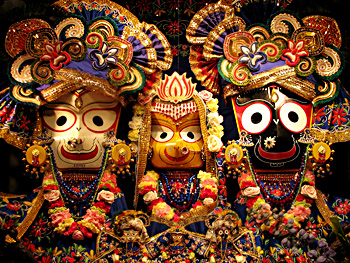 Devadasis of Jagannath temple in Puri have been greatly instrumental in bringing about the system of Odissi dance and music. The Devadasis, literally meaning the maidservants of the Lord were also known as Devaganikas or Devadarikas. The Devadasis of Puri were popularly known as Maharis. It is believed that the term Mahari comes from `Maharani` meaning Queen. This is because there are certain similarities between the Queen and the Mahari. Both the Queen and the Mahari do not ever adopt the signs of a widow. They are eternally Sadhaba (having a husband). Both of them are `mobile Goddess` and `auspicious ladies`. The Maharis used to serve the Mahasrama (the king). So they were called Maharis. Devadasis of Jagannath temple in Puri have been greatly instrumental in bringing about the system of Odissi dance and music. The Devadasis, literally meaning the maidservants of the Lord were also known as Devaganikas or Devadarikas. The Devadasis of Puri were popularly known as Maharis. It is believed that the term Mahari comes from `Maharani` meaning Queen. This is because there are certain similarities between the Queen and the Mahari. Both the Queen and the Mahari do not ever adopt the signs of a widow. They are eternally Sadhaba (having a husband). Both of them are `mobile Goddess` and `auspicious ladies`. The Maharis used to serve the Mahasrama (the king). So they were called Maharis. As per convention the Devadasis are married to Lord Jagannath and after becoming Devadasis they are expected not to marry again. Henceforward they are treated as Lord`s wife. That the Devadasis were held in high esteem, at one time is well proved by the fact that king Karna of Soma dynasty donated a village to a Devadasi named Karpura Sri. Later he also married her. Also, it is a well-known fact that the poet Jayadeva`s wife Padmavati opted to become a Devadasi.
Essentially, there are two types of Devadasis. There is one type of Devadasis who are offered by their parents to the Lord or who volunteer themselves to be Devadasis in fulfilment of a vow. They live as spinsters and lead a life of abstinence and austerity serving God as Devadasis. They were called Niuchhiali Dasis. The other kind are not expected to maintain Brahmacharya and for this reason were suspect in the eyes of the public. But both the kinds were generally called Maharis. The Mahari Seva, the services to be rendered by the Maharis, are mentioned in the section 75 and 76 of the Record of Rights prepared under the Puri Sri Jagannath Temple Administration Act, Orissa. The Devadasis are divided into two types, namely, Bhitara Gaauni and Samprada Nijoga. Though the works are divided among them, the nature of work does not differ much. They sing Mangala Gana during various auspicious functions in the temple or in the palace. When Krishna janma (birth of Lord Krishna) is dramatised in the temple, the Devadasis play the role of Yashoda and Rohini and breast-feed Krishna. They also accompany the processions of the Lord during various festivals. In some festivals the dance accompanies song, in some there is only dance and music and no song. The Devdasis dance and sing during the following festivals: Damanaka Chaturdasi, Doha, Pushyaviseka, Rath Yatra, Snan Yatra. During Dakshinayan they only sing. During various Dhupa (breakfast, lunch, dinner etc.) and while accompanying Chandan procession they dance to the tune of music and do not sing. In front of goddess Vimala, during Solapuja, they only dance. There is no music or song. The position of the Devadasis in society has courted quite a bit of controversy. Since Ray Ramananda`s time (16th century) when the Devadasis were freed from the bondage of temple discipline and participated in royal functions and public functions, they became suspect in the eyes of the public. Since last century they were held in low esteem. Only recently, when the system is virtually extinct, the system is being glorified. |
Tuesday, September 20, 2011
Jagannath temple
Subscribe to:
Post Comments (Atom)


No comments:
Post a Comment